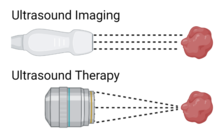
Back أمواج فوق صوتية علاجية Arabic Ultraschalltherapie German Terapia por ultrasonido Spanish Ultrasoinu terapeutiko Basque Ultrasonothérapie French Terapia por ultrasón Galician Գերձայնային բուժում Armenian ულტრაბგერითი თერაპია Georgian Ultrassom terapêutico Portuguese Terapevtik ultratovush Uzbek
This article needs more reliable medical references for verification or relies too heavily on primary sources. (August 2020) |  |
| Therapeutic ultrasound | |
|---|---|
| ICD-10-PCS | 6A7 |
| ICD-9-CM | 00.0 |
Therapeutic ultrasound refers generally to the use of ultrasound for the treatment of a medical condition or for therapeutic benefit. Physiotherapeutic ultrasound was introduced into clinical practice in the 1950s, with lithotripsy introduced in the 1980s.[1] Other uses of ultrasound for therapeutic benefit are at various stages in transitioning from research to clinical use and include: high-intensity focused ultrasound (HIFU), targeted ultrasound drug delivery, trans-dermal ultrasound drug delivery, ultrasound hemostasis, cancer therapy, and ultrasound assisted thrombolysis[2][3] Ultrasound used for therapeutic benefit often use focused ultrasound waves, however, unfocused ultrasound waves may also be used.[4]

In the above applications, the ultrasound passes through human tissue where it is the main source of the observed biological effect (the oscillation of abrasive dental tools at ultrasonic frequencies therefore do not belong to this class). The ultrasound within tissue consists of very high frequency sound waves, between 800,000 Hz and 20,000,000 Hz, which cannot be heard by humans.
Some of the advantages of ultrasound as a diagnostic and therapeutic tool include its safety profile, lack of radiation, portability, and low cost.[4] Therapeutic ultrasound in medicine ranges from extracorporeal shockwave therapy for the breaking of renal calculi to HIFU in which tumors are ablated. In the research field, use of ultrasound is being explored as a mechanism of enhancing drug delivery, sorting particles, and measuring properties of tissue.[2][5][6] In physical therapy, there is some evidence that ultrasound is more effective than placebo treatment for treating patients with arthritis pain,[7] a range of musculoskeletal injuries[8] and for promoting tissue healing.[9]
- ^ Robertson VJ, Baker KG (July 2001). "A review of therapeutic ultrasound: effectiveness studies". Physical Therapy. 81 (7): 1339–1350. doi:10.1093/ptj/81.7.1339. PMID 11444997.
- ^ a b Mo S, Coussios CC, Seymour L, Carlisle R (December 2012). "Ultrasound-enhanced drug delivery for cancer". Expert Opinion on Drug Delivery. 9 (12): 1525–1538. doi:10.1517/17425247.2012.739603. PMID 23121385. S2CID 31178343.
- ^ "Therapeutic Ultrasound: A Promising Future in Clinical Medicine". Archived from the original on October 12, 2007.
- ^ a b Cite error: The named reference
:1was invoked but never defined (see the help page). - ^ Cite error: The named reference
:5was invoked but never defined (see the help page). - ^ Constans C, Ahnine H, Santin M, Lehericy S, Tanter M, Pouget P, Aubry JF (February 2020). "Non-invasive ultrasonic modulation of visual evoked response by GABA delivery through the blood brain barrier". Journal of Controlled Release. 318: 223–231. bioRxiv 10.1101/351270. doi:10.1016/j.jconrel.2019.12.006. PMID 31816362. S2CID 209164551.
- ^ Wu Y, Zhu S, Lv Z, Kan S, Wu Q, Song W, et al. (December 2019). "Effects of therapeutic ultrasound for knee osteoarthritis: a systematic review and meta-analysis". Clinical Rehabilitation. 33 (12): 1863–1875. doi:10.1177/0269215519866494. PMID 31382781. S2CID 199452082.
- ^ Uddin SM, Komatsu DE, Motyka T, Petterson S (June 2021). "Low-Intensity Continuous Ultrasound Therapies—A Systematic Review of Current State-of-the-Art and Future Perspectives". Journal of Clinical Medicine. 10 (12): 2698. doi:10.3390/jcm10122698. PMC 8235587. PMID 34207333.
- ^ Leighton R, Phillips M, Bhandari M, Zura R (June 2021). "Low intensity pulsed ultrasound (LIPUS) use for the management of instrumented, infected, and fragility non-unions: a systematic review and meta-analysis of healing proportions". BMC Musculoskeletal Disorders. 22 (1): 532. doi:10.1186/s12891-021-04322-5. PMC 8196464. PMID 34116673.